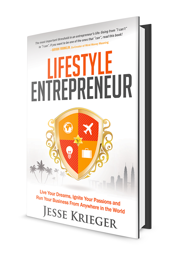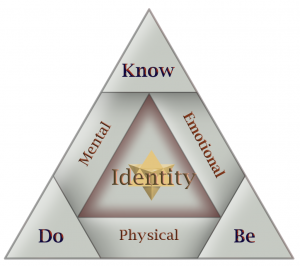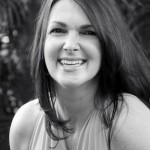Discover and Design Your True Identity
 Searching for your true identity or attempting to design your life to fit your true identity? Then you’ll enjoy today’s post from Jesse Krieger, author of Lifestyle Entrepreneur and our guest on the next Power Up Living show. Jesse has lived in, worked in, and traveled to more than thirty countries as a lifestyle entrepreneur, so he knows more than a little something about creating a framework for success based on true identity! Join us for what is sure to be an inspiring conversation as he shares the 5 Keys to Being a Successful Lifestyle Entrepreneur. ~KG
Searching for your true identity or attempting to design your life to fit your true identity? Then you’ll enjoy today’s post from Jesse Krieger, author of Lifestyle Entrepreneur and our guest on the next Power Up Living show. Jesse has lived in, worked in, and traveled to more than thirty countries as a lifestyle entrepreneur, so he knows more than a little something about creating a framework for success based on true identity! Join us for what is sure to be an inspiring conversation as he shares the 5 Keys to Being a Successful Lifestyle Entrepreneur. ~KG
By Jesse Krieger
When you want to make a transformational change—say you want to start a business or become a lifestyle entrepreneur and have more freedom and opportunity—you need to have an honest assessment of where you’re at, as a starting point.
In my post about overcoming limiting beliefs, we talked about the negative underlying assumptions you might have about the world. Do you think that people are out to screw you? Do you think that business people are all evil and corrupt? Do you think that the world is going to explode and the oceans are going to sweep over all the continents?
The list goes on and on, but you need to take an assessment of what underlying thought patterns you have that relate to your experience with the external world at large.
How Family and Social Expectations Affect Your Identity
First let’s talk about the reason for this. One of the things that really impacted me while learning from two of my mentors, Bryan Franklin and Jennifer Russell, was the idea of being totally right and OK with where you are right now. They told me to accept my current self, state and circumstances as perfectly constructed to give me maximum flexibility in choosing any direction I want to moving forward.
If you’re feeling stressed or pulled in a certain direction, whether that’s parents encouraging you to become a doctor or friends that are all going into banking, you need to be right with the current circumstances and not be in a place of having tension. You might feel like it would be a huge departure from your family or your core group of friends to go in a different direction and become an entrepreneur, but you need to be able to choose any direction that you do want to go and move decisively in that direction.
In any event, the beginning stages of discovering your identity involve first uncovering the underlying assumptions you have about the world, the expectations that people you care about have for you, and just acknowledging them. Write it down, make a journal entry or record them in some way to acknowledge they exist. That alone may be a relief.
Family systems are probably one of the largest influences on our worldview and we tend to adopt the mindsets, attitudes, prejudices, worldview and outlook that our parents have from a young age. So it seems like an extra layer of pressure when you’re thinking about starting a business or traveling or having a different type of lifestyle than many people around you in your social circle and family. Take an inventory of what people expect from you and then recognize that you have the decision, the autonomy, and the freewill to go in any direction that feels right to you.
One of the biggest takeaways in discovering your identity is knowing that it’s OK to try different things in life and that the consequences are rarely as large as we think they are.
The Discovering Your Identity Exercise

The Discover Your Identity Diagram – from Lifestyle Entrepreneur (US edition)
In terms of doing this self-analysis, this process of uncovering your underlying worldviews and so forth, there’s a framework that I use. The identity model in Lifestyle Entrepreneur centers around this philosophy, which is know, do, be. A sequence that happens as follows:
1. When you know what you want…
2. it becomes clear what must be done, and as you do …
3. eventually it will come to be your identity.
All the different businesses I’ve started over the past decade have been in different, unrelated fields. It was the experience that backed me into this framework—thinking about what led me from being in a rock band to becoming an investment banker to becoming a cofounder of a renewable energy credit startup to living all over Europe and becoming a dating coach.
Somewhere in this process of discovering your identity and moving in a new direction and into a new business or new role in life, at some point you realize “Wow, I’m here“. There’s this blurred line that you cross at some point where people now experience you as the person that you previously envisioned yourself being. It’s a great feeling!
Breaking Down the Know, Do, Be Framework
With the components of the identity framework, starting with the know, I’ve labeled what I call three internal identity drivers: your mental, emotional, and physical aspects.
Your mental is your thoughts, your intellect. Emotional is your passions, your feelings, things that insight most into you. Physical is how you manage your body and what shape you’re in, what you do for fitness, etc. Those are three signposts or guiding topics for this internal investigation.
The external identity drivers are how people experience you in the world. What are you known for? What do you know specific to an industry? What do you need to learn? Those are the things that people can tap into.
Then there’s do. To do the things you want to do, what are the actual actions? These, ironically, can be very different from what people perceive as the lifestyle or the things that somebody does day to day.
Learn what you need to do and be clear on what the actual actions are that comprise the identity and the lifestyle you want to have. Really find out what they are, then make sure that you’re OK with that and that you’re not grasping towards an illusory image of what this new role in your life could be.
The actual actions that you take ultimately that lead to who you are. That’s the be component, like a title or a business card that you can envision of your future self. When that becomes a reality and people experience you in that regard, then you’ve accomplished building a new identity around your passion.
Hope this post was helpful and remember to always learn what you need to know, to do what you love doing, so you can be the person you truly deserve to be!
Editor’s Note: Jesse delves more into the specifics of identifying and designing your internal and external identity drivers in subsequent posts – check out the next post in this 3-part series here: Discovering Your Internal Identity Drivers
About the Author
 Jesse Krieger was born and raised in San Francisco but spends three to four months a year traveling the world. Whether it’s climbing volcanoes with friends in the Mediterranean or consulting with clients from Malaysia to Manhattan, Jesse views the world as both a playground and a potential addressable market.
Jesse Krieger was born and raised in San Francisco but spends three to four months a year traveling the world. Whether it’s climbing volcanoes with friends in the Mediterranean or consulting with clients from Malaysia to Manhattan, Jesse views the world as both a playground and a potential addressable market.
During his twenties Jesse started over five companies and sold the last two. He has lived in, worked in, and traveled to more than thirty countries and speaks German and Mandarin Chinese in addition to his native English.
A graduate of UC Berkeley and formerly a touring rock guitarist, Jesse counts becoming a published author as his most recent achievement. When he is not consulting with clients on lifestyle and entrepreneurship, he can usually be found on a bicycle, pedaling up a steep mountain slope or yelling at the top of his lungs from the peak.

